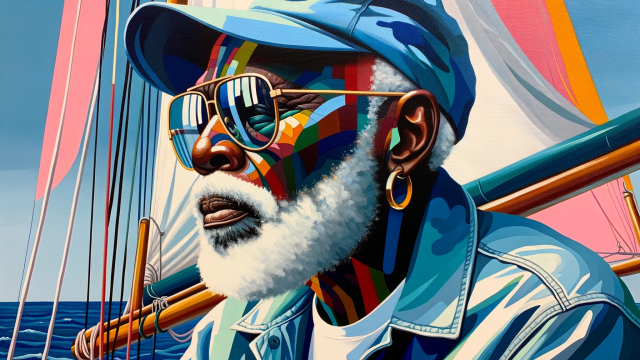The Amazing Journey of Bill Pinkney
Imagine leaving your life and the familiar touch of soil beneath your feet to sail across treacherous seas around the globe with only a few clothes, a navigator, limited water and food, and by yourself. William ‘Bill’ Pinkney did just that. He was the second African American to sail around seas solo and the first in history to navigate the world’s five great capes: South East Cape, Cape Horn, Cape of Good Hope, Cape Leeuwin, and Cape Agulhas.
Growing up on the Southside of Chicago, Pinkney was always fascinated by what was out there beyond his familiar surroundings. Pinkney had intentions of being an architect due to his love of creativity and the arts, but wanting to escape his hard life of systemic racism and poverty, he turned instead to the possibilities of life at sea and joined the Naval Reserve, where he developed his love for ocean-bound exploration. While performing his duties with the Reserve, Pinkney did not allow continued racism and discrimination to discourage him from following his dreams and his love for sailing and traveling.
After eight years of service with the navy and time spent in Puerto Rico, Pinkney, determined and relentless, navigated a different route working in various fields from conga player to professional makeup artist to lead positions for Revlon and Johnson Products as a make-up consultant. By the 1980s, he was lecturing at the prestigious Wharton School at the University of Pennsylvania, far from his Chicago roots and still yearning for the sea. Having experienced life across a spectrum of career fields, his passion and thirst for knowledge about the world beyond could not be quenched. At a certain point in his journey, he acquired his first sailboat, a 28-foot Pearson Triton he named Assagai, for the African spear and launched his long-awaited dream.
Accepting the Challenge
In 1985, 30 years into his journey, the 50-year-old admirer of the sea made the executive decision to become a historic trailblazer and circumnavigate the globe. Accepting the lonely challenge of the solo adventure ahead was something Pinkney had contemplated for some time, and recognized that his chance to accomplish his life’s goal was at hand.
With the help of family, friends, and investors, Pinkney was able to acquire the funds needed to seize the opportunity of becoming the first African-American sailor to whisk away into the treacherous waters of the five Great Capes. On August 5, 1990, Pinkney set sail from Boston Harbor for his history-making journey. During his extraordinary expedition, Pinkney traveled a total of 27,000 miles from cape to cape on The Commitment, a Valiant 47-foot single-masted boat cutter. In “The Incredible Journey of Bill Pinkney,” a documentary about his journey, he said, “If you are willing to make a commitment, if you are willing to learn what has to be learned to make your dream come true and are able to apply that and not let anything deter you, you can be successful.”
Documenting Discoveries Along the Way
During his voyage, Pinkney explored different parts of Africa and engaged in the rich culture he encountered as a way. to educate and encourage Black youth back home in America., Pinkney recorded aspects of everyday life at stopovers in South America as well, introducing students to a deeper understanding of Africa’s influence across the diaspora
In Salvador de Bahia, Brazil, for instance, he described the influence of African slaves on the city’s music and culture while filming capoeira—a hybrid martial arts-based dance form that originated among enslaved people. “I want to show my students at home how many of their fads like breakdancing had roots somewhere else,” he says in the documentary.
After returning from his voyage at sea in 1992, he continued his work as an educator, as well as an author and motivational speaker, but Pinkney’s journey of traveling did not end there. In 1999, Pinkney fulfilled the journey of the “Middle Passage,” the passage where millions of enslaved Africans were transported across the Atlantic Ocean in the 17th and 18th centuries. He also helped in the restoration of La Amistad, a slave ship in which slaves rebelled, took over, and freed themselves. Pinkney oversaw the ship as captain, sailing hundreds of students and people of all ages and colors and educating them about the history of racial inequality in the United States. According to the Washington Post, Pinkney said, “This boat is about a passport to freedom. It’s about resourcefulness and perseverance and self-reliance and commitment.”
Before his death on August 31, 2023, Pinkney encouraged people, predominantly Black people, to connect with the sea and to learn about the history of their heritage. He also inspired Black youth to defy the odds and not be held down by the stigmas labeled on them. His remarkable voyage and teachings about his hardships and journeys have earned him a significant place in American history and African history.
Editor’s Note
Traveling is a gateway to African culture and a better understanding of the African diaspora. At The Africa Channel, it is our mission to create a bridge that connects people to the wonders of the continent. Find other captivating stories in the programming presented by The Africa Channel and its SVOD channel, Demand Africa.

